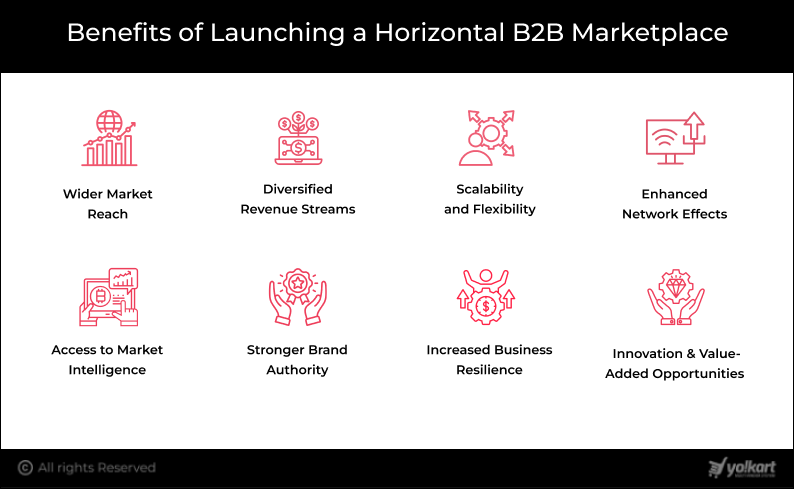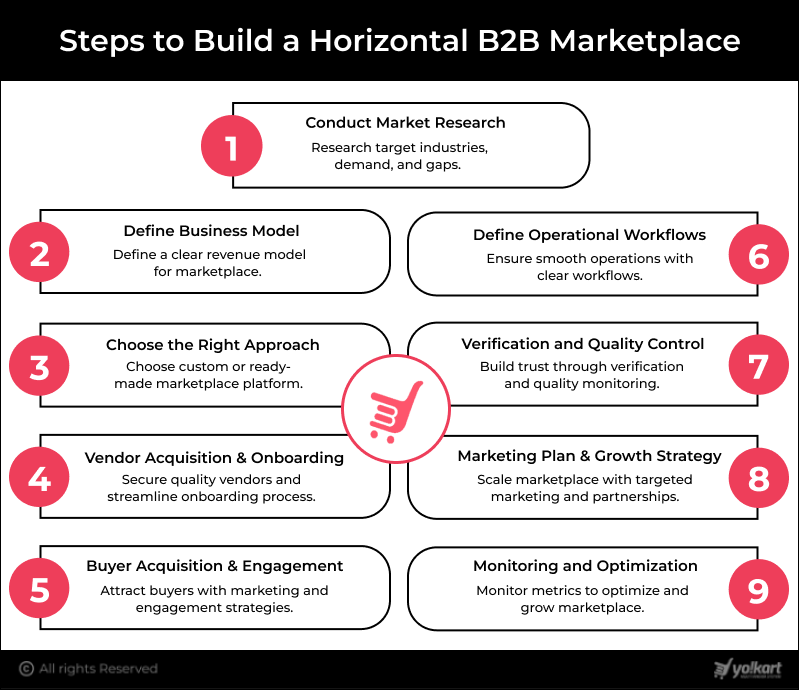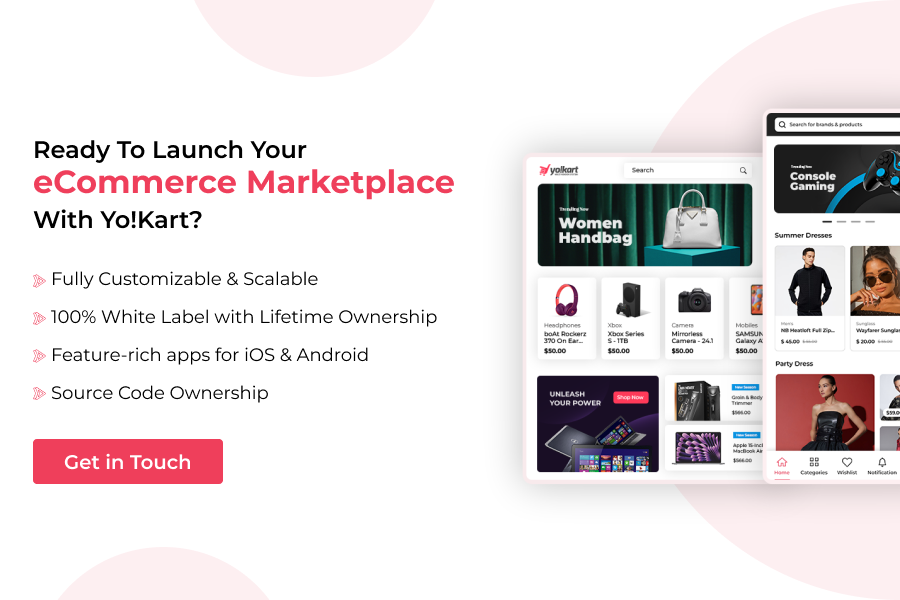Publishing Date: 8th Oct, 2025
The B2B marketplace landscape is evolving rapidly. With businesses seeking efficiency, wider reach, and diversified sourcing options, online B2B marketplaces are emerging as powerful platforms that facilitate online trade.
While vertical B2B marketplaces focus on a single industry, horizontal B2B marketplaces serve multiple sectors under one roof. They help businesses discover new suppliers, diversify their offerings, and explore markets they might not traditionally access.
In this blog, we will explore what a horizontal B2B marketplace is, the benefits it offers, real-world examples, and a step-by-step approach to building one.
Table of Contents
- What is a Horizontal B2B Marketplace?
- Examples of Horizontal B2B Marketplace
- Benefits of Launching a Horizontal B2B Marketplace
- Steps to Build a Horizontal B2B Marketplace
- Different Approaches to Build a Horizontal B2B Marketplace
- Choosing the Right Approach
- Cost to Build a Horizontal B2B Marketplace
- Conclusion
- FAQs
What is a Horizontal B2B Marketplace?
A horizontal B2B marketplace is a platform that connects buyers and sellers across multiple industries rather than focusing on a specific niche. Unlike vertical marketplaces that cater to particular sectors—such as electronics, apparel, or industrial goods—horizontal marketplaces offer a broad range of products and services spanning different categories. It can serve as an everything marketplace like Amazon, where sellers sell products from diverse industries and on the other hand, buyers can buy products from different categories on a single platform.
Key characteristics include:
- Cross-industry product catalog: Businesses from multiple sectors can buy and sell diverse products.
- Multi-vendor support: Allows multiple sellers from diverse industries to list and sell their products on the marketplace.
- Dynamic pricing: Supports bulk orders, special deals, and B2B-specific pricing models.
- Integrated payment and logistics systems: Ensures smooth and secure transactions via third-party integrations.
- Advanced search and filtering: Helps buyers find products efficiently across industries.
Horizontal marketplaces create ecosystems where businesses from different sectors can interact, collaborate, and grow.
Examples of Horizontal B2B Marketplace
Horizontal B2B marketplaces are not just a concept. Several global B2B marketplace giants fall under this marketplace type and are thriving in the eCommerce industry. These top B2B horizontal marketplaces are serving exceptionally and, of course, leading the industry for years.
1. Alibaba: One of the most prominent examples of a B2B multi-vendor marketplace that connects global businesses and enables them to trade products across diverse industries.
2. Amazon Business: Amazon Business serves around 8 million buyers and sellers across the industry. The main product categories include: Industrial & scientific supplies, office supplies, healthcare & lab supplies, facility maintenance, professional services, IT & electronics. Amazon Business carries a broad “business-grade” selection and has added more industrial/medical items in recent years.
3. eWorldTrade: It is another popular example of a B2B horizontal marketplace that enables multi-category B2B listings. These categories include agriculture and food, apparel, industrial machinery, electronics, consumer goods, and more.
4. Global Sources: Global Sources is also a prominent player in the B2B multi-vendor marketplace category. It connects a large number of verified suppliers with buyers selling products across diverse industries. Electronics, home and gift products, fashion and textiles, auto parts, and medical are a few categories that Global Sources serves. However, the marketplace is primarily known for offering electronics.
Benefits of Launching a Horizontal B2B Marketplace
Launching a horizontal B2B marketplace offers numerous advantages for businesses, investors, and vendors alike. By catering to multiple industries, these platforms create opportunities that go beyond the limitations of traditional B2B operations. Here’s a detailed look at the key benefits:

1. Wider Market Reach
Horizontal marketplaces allow businesses to connect with clients and suppliers across multiple industries. This broader reach not only increases visibility but also creates opportunities for cross-industry collaborations, partnerships, and trade that would be difficult to achieve in a single niche.
2. Diversified Revenue Streams
Serving multiple industries means revenue isn’t dependent on a single source. A horizontal marketplace can earn through transaction commissions, subscription fees, listing charges, premium services, and advertising across a diverse set of verticals. This diversification reduces financial risk and ensures sustainable growth.
3. Scalability and Flexibility
Horizontal marketplaces are inherently scalable. Businesses can add new categories, onboard vendors from new industries, and introduce innovative services without overhauling the platform. This flexibility allows the marketplace to adapt to market trends and evolving buyer needs.
4. Enhanced Network Effects
As more vendors join the platform across industries, the value of the marketplace increases for buyers. Similarly, a larger buyer base attracts more sellers. These network effects create a self-sustaining ecosystem where growth accelerates naturally over time.
5. Access to Market Intelligence
Operating across multiple sectors provides valuable insights into industry trends, buyer behavior, and supply-demand patterns. This intelligence can be utilized when making strategic decisions, help identify emerging opportunities, and give your marketplace a competitive edge over operating a vertical marketplace.
6. Stronger Brand Authority
Being a one-stop destination for B2B trade positions your marketplace as a market leader and an authoritative source for businesses seeking reliable suppliers. A well-managed horizontal marketplace builds trust, credibility, and long-term relationships with both buyers and sellers.
7. Increased Business Resilience
By diversifying across industries, horizontal marketplaces are less vulnerable to economic fluctuations in any single sector. If one industry slows down, others can compensate, making the business model more resilient and sustainable.
8. Opportunities for Innovation and Value-Added Services
With a diverse vendor and buyer base, horizontal marketplaces can introduce innovative features such as AI-driven product recommendations, cross-industry analytics, logistics optimization, or integrated financing options, creating additional value for users.
Launching a horizontal B2B marketplace is not just about connecting buyers and sellers; it’s about creating an adaptable, diversified, and intelligent platform that thrives on cross-industry collaboration, insights, and innovation. It provides diversified opportunities to grow and expand across industries.
Want to Launch a Thriving B2B Multi-Vendor Marketplace?
Steps to Build a Horizontal B2B Marketplace
Launching a successful horizontal B2B marketplace requires a careful blend of market research, business strategy, operational planning, and the selection of the right technology platform. Unlike vertical marketplaces that focus on a single industry, horizontal marketplaces span multiple sectors, which adds complexity but also increases growth opportunities. Here’s a detailed, step-by-step approach to building one:

1. Conduct In-Depth Market Research
Before starting, it is essential to understand the industries you want to target. Identify the demand patterns, supply gaps, and pain points for buyers and sellers across different sectors. Analyze competitors to see what works and where the market is underserved. This research helps determine which industries to prioritize first, what types of products or services to offer, and how to position your marketplace effectively.
2. Define Your Business Model
A clear business model is critical for sustaining and scaling a horizontal marketplace. You need to decide how your platform will generate revenue. Common approaches include:
- Transaction-based fees: Charging a commission for every successful order processed through the marketplace.
- Subscription plans: Monthly or annual fees for vendors to access premium features, listing options, or analytics.
- Listing and promotional fees: Charging vendors to highlight products or services.
- Value-added services: Offering services like logistics, financing, analytics, or marketing support.
Choosing the right revenue model helps balance profitability while keeping the platform attractive for vendors and buyers.
3. Choose or Build the Right Platform
Technology is the backbone of any horizontal B2B marketplace. At this stage, you need to decide how the platform itself will be built:
- Custom Platform Development:
Build a solution from scratch tailored to your exact requirements. This allows full flexibility in features, workflows, and integrations. However, it requires a higher investment of time, resources, and technical expertise. - Ready-Made Marketplace Solutions:
Utilize pre-built platforms like Yo!kart B2B, dedicatedly designed for B2B marketplaces. These solutions come with multi-vendor management, cross-industry catalogs, secure payment gateways, and analytics features. They are cost-effective and allow faster time-to-market.
Selecting the right platform ensures your marketplace can scale efficiently, accommodate diverse products, and support a seamless experience for both buyers and sellers.
4. Vendor Acquisition and Onboarding
The success of a horizontal marketplace depends heavily on the quality and diversity of vendors. Identify suppliers across different industries who can deliver consistent quality and reliability. Develop a streamlined onboarding process, providing guidance on how to list products, set prices, and manage orders. Offering training, support, and incentives for early vendors can help build a strong foundation.
5. Buyer Acquisition and Engagement
Attracting buyers is equally important. Highlight the marketplace’s diversity, ease of use, and competitive pricing. Use targeted marketing campaigns, partnerships with industry associations, and early adopter incentives to attract buyers from multiple industries. Maintaining high engagement through newsletters, promotions, and personalized recommendations ensures buyers keep returning.
6. Define Operational Workflows
Efficient operations are crucial for building trust and ensuring smooth transactions. Create clear processes for:
- Order management
- Payment processing
- Returns and refunds
- Customer support
Well-defined workflows help reduce friction for both buyers and sellers, improve satisfaction, and foster loyalty.
7. Implement Vendor Verification and Quality Control
Maintaining trust is essential, especially in a horizontal marketplace that spans multiple industries. Verify vendors before onboarding, monitor product/service quality, and establish a rating or review system. Regular audits and compliance checks help maintain credibility and minimize disputes.
8. Develop a Marketing and Growth Strategy
Marketing is key to scaling your marketplace. Focus on:
- Industry-specific campaigns targeting multiple sectors
- Strategic partnerships with trade organizations
- Participation in trade fairs or exhibitions
- Referral programs and loyalty incentives for buyers and vendors
The goal is to create strong network effects: as the number of vendors grows, it attracts more buyers, and a larger buyer base encourages more vendors to join.
9. Monitor Performance and Continuously Optimize
Finally, track critical performance metrics such as transaction volumes, vendor engagement, buyer satisfaction, and revenue growth. Use these insights to optimize processes, expand product categories, refine marketing strategies, and improve the overall user experience. Continuous monitoring ensures the marketplace evolves in line with market needs and remains competitive.
Different Approaches to Build a Horizontal B2B Marketplace
When building a horizontal B2B marketplace, choosing the right development approach is crucial, as it directly affects cost, time-to-market, scalability, and long-term growth. Broadly, there are two main approaches:
1. Custom Development
Overview:
Custom development involves building a marketplace platform from scratch according to your unique business requirements. This approach is suitable for businesses that want full control over design, functionality, and integrations.
Advantages:
- Full Customization: Every feature, workflow, and interface can be tailored to your specific vision.
- Unique Differentiation: Enables innovative features that competitors cannot replicate easily.
- Integration Flexibility: Custom-built solutions allow seamless integration with ERP, CRM, accounting, or logistics systems.
- Scalability: Designed to handle future growth and industry expansion efficiently.
Challenges:
- Higher Costs: Custom development can be expensive, often ranging from $50,000 to $250,000 or more depending on complexity.
- Longer Timeline: Typically takes 6–12 months to launch, including design, development, and testing.
- Maintenance Responsibility: Ongoing updates, bug fixes, and enhancements must be handled in-house or via a development partner.
Best for: Businesses with specific operational needs, complex workflows, or a desire for a fully proprietary solution.
2. Ready-Made Marketplace Solutions
Overview:
Ready-made solutions are pre-built platforms designed to launch multi-vendor marketplaces quickly. They come with essential B2B features like vendor management, cross-industry catalogs, secure payments, and analytics, enabling faster deployment.
Advantages:
- Faster Time-to-Market: Pre-built features allow businesses to launch in 1–3 months.
- Cost-Effective: Significantly lower upfront costs, typically ranging from $499 to $30,000.
- Built-In Scalability: They are built with scalability in mind. They support growth and expansion without disrupting the marketplace performance.
- Technical Support and Updates: Platforms often come with regular updates and dedicated technical support.
Challenges:
- Limited Customization: Some features may not be fully adaptable to unique business processes. However, a readymade solution like Yo!Kart is fully flexible with customization. It allows you to tailor the solution according to your personalized marketplace requirements.
- Dependency on Provider: Platform updates and technical decisions are controlled by the solution provider. However, by opting for a self-hosted software like Yo!Kart, you can gain complete control.
- Potential Feature Gaps: Advanced integrations or industry-specific tools may require additional customization. Yo!Kart enables third-party integrations. The software allows you to integrate APIs or third-party tools effortlessly.
Best for: Startups or growing businesses that want to enter the market quickly, reduce costs, and leverage a proven platform with essential B2B marketplace functionality.
Looking for a Readymade Horizontal B2B Marketplace Software?
Choosing the Right Approach
Selecting between custom development and ready-made solutions depends on your:
- Budget: Custom builds require higher investment; ready-made solutions are more affordable.
- Timeframe: If you want a rapid launch, ready-made platforms are ideal.
- Business Complexity: Complex operations or unique workflows may necessitate custom development. However, choosing a 100% customizable readymade solution can solve this concern.
- Growth Plans: Both approaches help you grow and expand your business. Nevertheless, it’s crucial to choose the right one that perfectly aligns with your budget and requirements.
Many successful marketplaces adopt a hybrid approach: launching initially on a ready-made solution to test the market, then gradually migrating to a custom platform as their business scales and unique requirements emerge. However, if you choose Yo!Kart as your ready-made solution, you don’t need to migrate to a custom-built platform for scalability and unique features. The solution itself supports growth and expansion and lets you implement customizations easily.
Cost to Build a Horizontal B2B Marketplace
Understanding the cost of building a horizontal B2B marketplace is critical for allocating the budget. Costs vary depending on the approach you choose, the features you want, the number of industries you plan to serve, and whether you opt for custom development or a ready-made solution.
1. Custom Development
Overview:
Custom development involves building your marketplace from scratch according to your specific requirements. This approach offers maximum flexibility and allows you to implement unique workflows, features, and integrations.
Estimated Cost: $30,000 – $100,000+
Timeframe: 6–12 months
Factors Affecting Cost:
- Feature Complexity: Advanced vendor management, AI-driven recommendations, analytics, and multi-currency payment gateways increase development costs.
- Platform Scale: Supporting thousands of products and users across multiple industries requires more robust infrastructure, raising costs.
- Integrations: Connecting with ERP, CRM, logistics, or accounting systems adds to expenses.
- Design and UX: Custom user interfaces and seamless experiences for both buyers and sellers require additional investment.
2. Ready-Made Marketplace Solutions
Overview:
Ready-made solutions are pre-built platforms designed for quick deployment. They come with core B2B features like vendor management, cross-industry catalogs, secure payments, and analytics, enabling faster launch.
Estimated Cost: $2,000 – $10,000
Timeframe: 1–3 months
Factors Affecting Cost:
- Number of Vendors and Products: Some platforms charge based on vendor subscriptions or product listings.
- Additional Features: Integrations with logistics, payment gateways, or analytics tools may incur extra costs.
- Customization: Minor design tweaks and feature additions can slightly increase the investment.
Cost Comparison Table
| Approach | Estimated Cost | Timeframe | Pros | Cons |
| Custom Development | $30,000 – $100,000+ | 6–12 months | Fully tailored, unique features, full control | Higher cost, longer timeline, requires in-house maintenance |
| Ready-Made Solutions | $2,000 – $10,000 | 1–3 months | Faster launch, cost-effective, scalable, and technical support included | Flexibility with customization depends on the software you choose. |
Conclusion
Building a horizontal B2B marketplace opens doors to multiple industries, diversified revenue streams, and scalable growth. Success requires a clear business model, strategic vendor and buyer acquisition, efficient workflows, and the right technology platform.
For businesses looking to launch quickly while maintaining full control and flexibility, Yo!Kart’s self-hosted B2B marketplace solution offers a robust, scalable platform with multi-vendor management, cross-industry catalogs, secure payments, and analytics—helping entrepreneurs focus on growth rather than technical complexities.
A horizontal B2B marketplace is more than a trading platform—it’s an ecosystem for collaboration, expansion, and long-term business success. With careful planning and the right tools, you can establish a marketplace that thrives across industries.
FAQs
Q 1. What is a horizontal B2B marketplace?
Ans. A horizontal B2B marketplace is an online platform that connects buyers and sellers across multiple industries, unlike vertical marketplaces that focus on a single niche. It enables businesses to diversify product offerings, expand their reach, and scale operations efficiently.
Q 2. How is a horizontal B2B marketplace different from a vertical B2B marketplace?
Ans. Horizontal marketplaces cover multiple sectors, offering a wide range of products and services, whereas vertical marketplaces focus on a single industry or product category. Horizontal marketplaces drive larger network effects and provide opportunities for cross-industry trade.
Q 3. How can I launch a horizontal B2B marketplace quickly?
Ans. You can launch efficiently using a self-hosted ready-made platform like Yo!Kart, which provides multi-vendor management, cross-industry catalogs, secure payments, and analytics. This reduces development time and allows businesses to focus on growth strategies.
Q 4. What features are essential for a successful horizontal B2B marketplace?
Ans. The essential features required for a successful Horizontal B2B marketplace include:
- Multi-vendor onboarding and management
- Advanced product search and filtering
- Secure payment gateways and order management
- Analytics and reporting dashboards
- Vendor verification, reviews, and ratings
- Marketing and promotional tools for vendors
Q 5. How much does it cost to build a horizontal B2B marketplace?
Ans. Costs vary based on your approach:
- Custom Development: $30,000 – $100,000+, with longer timelines but full flexibility.
- Self-Hosted Ready-Made Platform (Yo!Kart): $2,000 – $10,000, faster deployment, scalable, and fully controllable.
Q 6. Can small businesses or startups create a horizontal B2B marketplace?
Ans. Yes. With platforms like Yo!Kart, even startups can launch multi-industry marketplaces quickly, maintain full control over data and hosting, and scale their operations across multiple industries without heavy upfront investment.
Q 7. What are the common challenges in running a horizontal B2B marketplace?
Ans. The B2B marketplace operators often face challenges in operating a B2B marketplace. These common challenges include:
- Managing vendors from multiple industries
- Maintaining consistent product/service quality
- Ensuring smooth transactions and payments
- Scaling operations as the marketplace grows
Using a reliable platform like Yo!Kart helps overcome these challenges with built-in workflows and management tools.
Q 8. How do I attract buyers and vendors to a horizontal B2B marketplace?
Ans. Attract buyers and vendors by offering diverse products, competitive pricing, and reliable service. Run targeted digital marketing campaigns, provide incentives, and leverage trade partnerships. Platforms like Yo!Kart also include marketing tools to support vendor promotions and buyer engagement.




